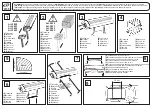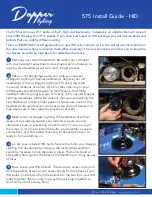
11.4.3 System Working Principle
11.4.3.1 System Working Principle
Headlamp Working Principle
When the headlamp switch is at "headlamp" position, the
working voltage is provided by terminal 8 to pull-in headlamp
relay and light up headlamps. Headlamp supply voltage is sent
to the headlamp adjustment switch and the left and right
headlamp adjustment motors. Moving up and down the switch
can change the adjustment adjustment motor signal voltage, to
achieve the headlamp height adjustment.
Note
Moving this button too frequently may cause motor
inoperative or damage.
When BCM (the center controller) detects the headlamp switch
terminal 12 voltage, it means the switch is at "AUTO"
(automatic transmission), at this time BCM will monitor the
ambient light sensors signal. If the ambient light is not strong,
BCM sends power from IP29 terminal 31 to drive the headlamp
relay, the headlamps will be automatically lit. When the ambient
light is increased, BCM will cut off the power supply output,
headlamps will be automatically off.
When the lighting switch is at high beam position, the working
voltage is from the switch terminal 7 to drive high beam relay,
at the same time the high beam power supply voltage is
transmitted to the instrument panel to light high beam indicator.
Note
High beam relay working voltage is from the headlamp
power supply circuit.
Park Lamp Working Principle
When the headlamp switch is at "headlamp" position, the
working voltage is sent from terminal 14 to drive the park lamp
relay and illuminate all park lamps, instrument lights, as well as
left and right license plate lamps; at the same time this voltage
is sent to the backlight adjustment switch, this switch can be
used to adjust the backlight brightness.
Note
The BCM connector IP29 terminal 16 can also be used
to drive park lamp relay, for example, when the vehicle
is unlocked with the remote control, BCM light park
lamps through this circuit.
Front Fog Lamp Working Principle
Front fog lamps relay coil drive power supply is from the park
lamp power supply circuit. When the front fog lamp switch is
turned on, the switch ground circuit will drive the front fog lamp
relay. The working voltage through the relay will light front fog
lamps. At the same time this voltage is sent to the instrument
panel front fog lamp indicator.
Note
Note that front fog lamps working voltage will be sent to
rear fog lamps at the same time.
Rear Fog Lamp Working Principle
When the rear fog lamp switch is turned on, the power supply
from the front fog lamps will drive the rear fog lamps relay and
light rear fog lamps, while the voltage is also sent to the
instrument panel front fog lamp indicator.
Note
Note: The sedan has a separate rear fog lamp assembly;
hatchback has only one rear fog lamp, located inside the
left tail assembly.
Turn Signal Working Principle
The multi-function lever controls light switch terminals 1 and 3
ground circuits. This ground signal is sent to BCM. BCM lights
the left and right turn signals through IP28 terminals No.4,13
respectively.
Note
When the hazard warning lamp button is pressed, BCM
will send output voltage to these two circuits at the same
time to light all turn signal lamps.
Brake Lamp Working Principle
The brake lamps are controlled by the brake lamp switch on
the brake pedal. When the brake pedal is pressed. the working
voltage is directly sent to the brake lamp bulb.
Note
Sedan high mounted brake lamp is located on the rear
parcel shelf inside the rear window. Hatchback high
mounted brake lamp is located at the top of the
hatchback.
Reverse Lamp Working Principle
Reverse lamps are controlled by the reverse lamp switch.
When the vehicle is at reversing, the working voltage is directly
sent to the brake lamp bulb.
Body Electric
Lighting System
11-67
EC718/EC718RV EC715/EC715RV 10/2009
Summary of Contents for EC715 2009
Page 4: ......
Page 330: ...Next Step 10 End 2 248 Fuel System JL4G18 D Engine EC718 EC718RV EC715 EC715RV 10 2009 ...
Page 1164: ......
Page 2008: ......
















































